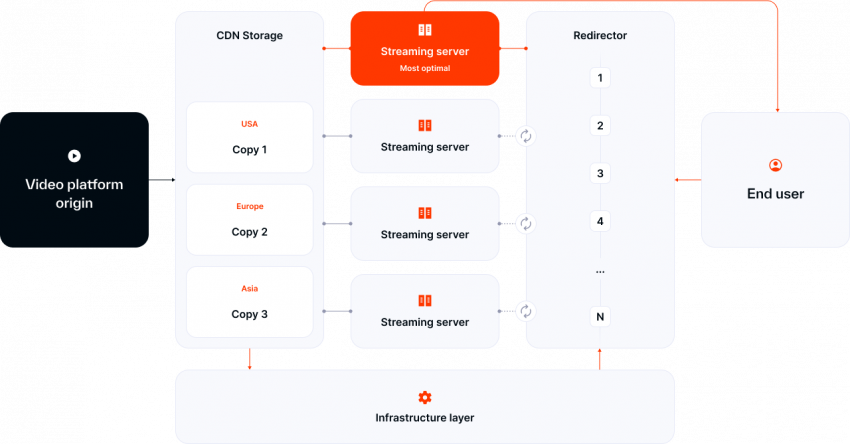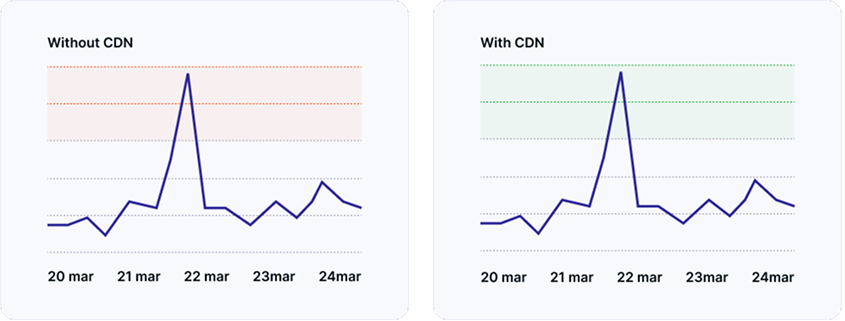The modern user expects instant access. Demands it. If a website takes over three seconds to load, 40% of people will leave it. For mobile apps, that figure climbs to 53%. High-definition streaming, e-commerce, online gaming, and real-time chats have forever lifted the standard for digital services. Meeting today’s expectations calls for high-performance, sturdy systems that can manage millions of users with almost no delay. A Content Delivery Network (CDN) is exactly such a system. But what is a CDN exactly?
At this point, CDNs are essentially the groundwork for the digital experience ecosystem. 90% of internet traffic bound for consumers flows through them. They reduce crucial metrics like Time to First Byte (TTFB), help ensure consistent delivery of content across regions, and prevent server overload. Since we live in a world where performance equals competitiveness – implementing a CDN is a way to forge strategic business advantage – not just an advantageous technical consideration – for companies of every size, in any industry.
For technical leaders in various roles – think DevOps leads or VPs of Engineering – scaling infrastructure is a challenge and a goal. It underpins wider objectives. Whether they are after unlocking new markets, aiming to boost the reliability of their sites, or trying to diversify delivery across more providers – they’re always looking for ways to tweak the system for peak efficiency. CDNs are one of the foundational pieces in that puzzle.
Today’s article aims to uncover their inner workings, detail the specifics of how they’re used, and explain the main types.
What is a CDN?
Put simply, it’s a network of servers spread across regions, where each node hands content to the nearest users. The idea is straightforward: If you’re in Sweden visiting a site whose main server is in the U.S., a Swedish CDN node steps in to deliver the content instead. This drastically reduces latency, benefiting the user, and saves resources for the provider’s server.
Let’s break down the name:
Content
Delivery
Network
Why Do Websites and Apps Use CDNs?
The first reason is speed. Picture a website hosted on a server in Brussels with 200 users: 100 in Brussels, 100 in Sydney. When one of the Australians tries to enter the site, their request has to zip 10,363 miles to Brussels and back to get the data. This translates into 200ms of loading time. But a Brussels local will get the same request serviced in just 5ms. The farther the user, the longer the haul, the slower the load.
A CDN levels the playing field. It adds another auxiliary endpoint in Sydney and thus reduces the distance between the Australian’s device and the server. The loading time is then the same for both.
These endpoints are called points of presence (PoPs), and CDNs typically have tens or even hundreds of them around the globe to serve users in different countries without delays.
But raw distance is not the only factor in quick delivery. CDNs also employ various network routing mechanisms to pick the path where each request travels the fewest number of hops (intermediate devices). Furthermore, they monitor network congestion to determine the clearest routes through which to send the data.
On top of that, CDNs have established relationships with ISPs, which allow them to place nodes within their networks and pipe content straight to their users.
The second benefit is server offload. Suppose you’re running an e-commerce shop on one server. Then, somehow, one of your promo campaigns explodes – some TikTok star promotes your merchandise – and thousands of new users suddenly flock to your site. Without a CDN, your lone server has to handle every request: fetching files, churning out custom pages, and sending data across the world. The consequences of this could either be a huge bill for used-up resources or worse – if your CPU, memory, or bandwidth aren’t sufficient, the server can choke, which would lead to dropped requests, and eventually a site crash.
A CDN is designed to prevent this. Its PoPs store copies – static images, pre-cooked files, and CSS – of your website’s files and deliver them to users without the main server’s involvement. So, in the case of a spike – say 10,000 users hit the store at once – the main server will only be utilized for 100 requests, those needing dynamic, uncached materials. The other 9,900 will just get cached copies from the CDN. It’s a buffer that keeps websites and apps working steadily under any load.
The previous two points naturally flow into the next one: boosting user experience. There are many ways CDNs make a website or app feel seamless. They eliminate the frustration of waiting – pages load fast, videos stream without pause – which helps create immersion. They also have the capability to adapt to different device types and network conditions. This ensures the experience is always smooth and tuned to the user’s setup.
And beyond that, CDNs can come with extra features that are hard for most teams to build in-house. These could be related to security, compression, advanced analytics, and more.
How a CDN Works (A Simplified Explanation)
Now that we understand the key concepts at a high level, let’s dive a bit deeper into a CDN’s inner workings. Since there are various types of CDN architectures, which have specific delivery sequences, we’ll provide a very generalized description.
First, a user types a web address into a browser. This could also be an app sending an API call. The request could be for a webpage, a video, a live stream, a set of small images, etc.
The browser or API then reaches out to the Domain Name System (DNS), whose function is to translate the human-comprehensible name – e.g., “website.com” – into a machine-friendly IP address.
Next, the DNS directs the browser or API to a specific IP address within the CDN’s infrastructure. The choice of the server could be tied to geographical proximity or other factors, and the specifics of this selection process vary among CDN providers. The gist is – CDN chooses the IP address of the appropriate PoP to the browser or API.
A cache check follows. If a cached copy of the requested content is already stored on the server, it gets delivered instantly. If it’s missing, the CDN fetches the data from the source, stores a copy at the PoP for subsequent requests, and then serves it to the user.
In some CDN setups, the content may also go through real-time optimizations, like resizing, compression, to further speed up delivery.
Finally, the data – cached or freshly retrieved – reaches the user. The end result is the browser rendering the website, the app processing API data, the player streaming a video, and so on.
It’s important to note that this is a simplified overview. This description largely pertains to CDNs heavily relying on Anycast – an IP network addressing scheme where multiple servers share the same IP address. However, numerous different configurations and mechanisms can power CDNs. Hopefully, though, this has provided you with a general understanding.
Different Types of CDNs
CDNs can be classified by scale, purpose, operational models, architecture, and more. Here, we’ll look at three concrete examples of CDN architectures from Advanced Hosting.
Redirect-Based CDN
These networks use HTTP redirects to guide users’ browsers and applications to the optimal edge server. Our solution, optimized for video streaming, has a four-component architecture:

- The storage server layer holds the heaviest load. These nodes have the most capacity. They pull data from the origin, replicate it – three copies per file – to build redundancy, resilience, and help with load balancing.
- The streaming servers are next in the capacity hierarchy. They run specialized algorithms to identify which content is hot, and where. They pull and store the most popular files, based on regional demand, and dispose of the least requested data. In terms of structure, they’re just like the storage nodes – but smaller and managed differently; no triple-copy logic here.
- The redirection layer, which controls and distributes traffic based on a predefined set of rules. Our redirector analyzes 50 different parameters to optimize both speed and security before a request is sent to a PoP. Here’s how it works:
- If a user requests cdn.advancedhosting.com/
video007.mp4, the redirector evaluates factors like location, network congestion, etc. - It then issues an HTTP redirect to chicago.streaming
.advancedhosting.com, the optimal edge server for this instance. - In addition to that, it activates anti-hotlink protection to prevent pirate sites from embedding videos onto their websites and using up bandwidth.
- One more thing: the redirector layer also stores and can serve files – but only small ones, like manifests and the first two video chunks. It speeds things up.
- If a user requests cdn.advancedhosting.com/
- The infrastructure layer, which keeps the whole thing running. Since Video CDN is a cloud setup, there are management servers in the background that handle orchestration and file distribution.
Scale with confidence. Learn how our Video CDN optimizes large-file delivery.
Anycast CDN
In Anycast CDNs, the PoPs all use the same IP address, and requests are directed by the standard decentralized routing protocol known as BGP (Border Gateway Protocol), which chooses the optimal edge server. These networks are better suited to handle static data and small objects – images up to 50MB, CSS, JS files, etc.
Advanced Hosting’s Anycast CDN has 23+ PoPs across Europe, the US, Asia, and South America. Its architectural design is simpler than that of the Video CDN. In the simplest configuration, it’s just a layer of nodes scattered across the world, all sharing the same Anycast IP address, but each with its own unique Unicast address, used to pull content from the origin. Once they get the needed files, they cache them for subsequent delivery.
In a more advanced setup, additional shield node(s) with larger cache memory are added. These have a close and quick connection to the origin. In this case, when PoPs don’t have the content in their storage, they can pull from the shield node instead of straining the origin.
There are also additional features, like:
- SSL encryption management – free SSL certificates to secure content.
- Cache warm-ups, e.g., preloading expected requests into the cache, expediting delivery even more.

What Content Can a CDN Handle?
While CDNs were originally created to only deliver static content, they’ve evolved and can now carry most information on the web. Let’s review the kinds of data they typically store:
- Static assets. These data objects don’t require updating. Examples: JPEG or PNG logos, fonts, front-end code elements (CSS and JavaScript files). Static data comprises the building blocks of most websites and applications. When they’re uploaded to the origin server, a CDN mirrors them across its network, and then the PoPs deliver cached copies to the users in close proximity, which alone reduces the loading time significantly. As we’ve mentioned, additional tweaks and compression to optimize data for different devices can also be performed, e.g., images from the main website can be tailored to mobile app use, without engaging the main server.
- Website content like product pages, blog posts. This could be full or partial webpage content, which usually consists of a mix of static layouts and dynamic elements such as stock levels and the visitor’s name (if it’s an e-commerce store). For fully static pages – landing pages, blogs – a CDN typically stores the HTML files at the edge in their entirety. When a request comes through, the cached copy is immediately served. If they feature dynamic elements, the edge server fetches them either through API calls or direct origin pings and stitches the static and dynamic parts together.
- Heavy Files. These are large media files, like MP4s or other video formats. They make up the core of streaming content – movies, shows, music videos, tutorials, lectures, and more. Unlike static assets, these files are often massive and require special handling to ensure smooth delivery. When a video is uploaded to the origin server, a CDN distributes it across its network of servers – either in full or in chunks, depending on node configuration. When someone wants to watch a video, the CDN typically doesn’t send the entire file at once. Instead, it uses protocols like HLS or DASH, which break the content into small segments. This allows the video quality to adapt based on the user’s internet speed. For example, someone on a slower connection receives lower-quality segments, while a user on fast Wi-Fi gets HD. This significantly reduces loading times and buffering.
Common CDN Use Cases
Let’s now look at the advantages CDNs bring by reviewing common applications.
A website loads slowly in distant regions
Delivering content to users across geographies from a single server is impractical. With a properly implemented CDN, load times shrink as data is sent to each user from nearby edge nodes, cutting delays. Users experience faster page rendering, which keeps them on the site longer and reduces abandonment. The result? The site’s global accessibility improves without large infrastructure costs. The origin server faces less traffic, easing resource demands and lowering bandwidth expenses.
A video platform needs smoother playback
No streaming service striving to be relevant can allow buffering. CDNs, like Advanced Hosting’s Video CDN, help ensure fast and uninterrupted streaming to users everywhere. The widespread network of PoPs delivers clips at low latency and adjusts the bitrate. The origin server is freed of most delivery tasks, which drastically lowers operational costs and helps video providers scale easily and show their content to large audiences without hiccups.
A SaaS app needs evenly fast performance globally
SaaS applications send dynamic API information worldwide. When they rely solely on the origin server, lags are inevitable whenever the load or user-server distance grows too big. Unresponsiveness is extremely detrimental to the SaaS business model, and a CDN’s capability to cache semi-static data – such as analytics with short expiration – helps prevent it. When interactions are clean and fast, no matter where the user is, acquisition and retention rates tend to increase, and loyalty spreads. The origin server, in turn, can conserve processing power by only handling uncached requests. So, for SaaS applications, CDNs are a way to support worldwide growth.
An e-store is preparing for a high-traffic event
E-commerce stores often experience high-traffic events. To ensure their site doesn’t crash during a massive sale, they must plan in advance for distributing the load during the potential spike. CDN PoPs, storing static assets such as images and page layouts, can serve the bulk of the data. A CDN’s load balancer or a redirector helps avoid downtime by distributing traffic across multiple edge servers for stability. This ensures transactions are processed quickly and server costs stay manageable since only small pieces of data – the dynamic elements – are delivered from the main server.

How CDNs Improve SEO and User Experience
For Google’s ranking algorithms, page speed is one of the most significant factors, especially for mobile, and so is user experience. By reducing latency, CDNs help improve both. Provided the quality of your content is high and site architecture is optimized, they can be a key part of your broader SEO strategy.
CDNs also have a major impact on metrics like Time to First Byte (TTFB) and Largest Contentful Paint (LCP). The minimized distance between user and server, efficient delivery of large content, and optimizations such as exchange protocol tuning, compression, and caching all facilitate better rankings.
Lastly, CDNs improve mobile performance – something both Google and end users care about deeply. In the mobile world, slow loading leads to instant abandonment. By reducing data transfer times and optimizing load speeds across varying network conditions, CDNs directly contribute to higher engagement and lower bounce rates on apps.
Smarter routing, faster delivery. Start using our Anycast CDN
When Do You Need a CDN?
Global audience
A no-brainer. If your audience is spread out geographically – or there is rapid growth across regions – a resilient CDN is instrumental in ensuring low latency and consistent performance for all of them.
Frequent traffic spikes
CDNs help scale and prepare for sudden surges in traffic. With a network of PoPs at your disposal, you can seamlessly handle large loads without service interruptions, origin server overstraining, or excessive overhead.
Large media files
For websites hosting bandwidth-intensive data (e.g., high-definition videos) or those requiring ultra-fast load times for crucial interactions, CDNs are a vital infrastructure element. They help optimize delivery speed and cost-effectively distribute large data by sending cached segments to the user without overburdening the origin server.
24/7 uptime
Lastly, companies that cannot afford any downtime or performance degradation – such as those in finance, e-commerce, or iGaming – can also benefit extensively from using CDNs. Besides providing data redundancy and minimizing downtime, these networks help establish fault tolerance.
Choosing the Right CDN Architecture
Here are some high-level considerations for when you’re trying to find a CDN that aligns with your needs.
- Redirect-based CDNs handle big files better. Anything over 50MB – they’re built for it.
- Anycast CDNs are a good fit if you mostly serve small, static files and want to spread them cost-effectively. If your content is light – small assets or even a few-second clips – using the video CDN would be overkill.
The thought to take away is that it all boils down to file size.
Redirect-based CDNs have a more tailored traffic management with predefined rules, but are more expensive due to their intricate architecture.
Anycast CDNs function more like a managed solution, as BGP determines which PoP to send requests to. However, they could potentially be easier to manage.
The most practical option is not necessarily the most feature-rich or expensive one. The right CDN architecture should match the characteristics of your content as well as the needs of your target audience.

